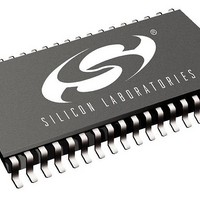SI3215M-C-GM Silicon Laboratories Inc, SI3215M-C-GM Datasheet - Page 29

SI3215M-C-GM
Manufacturer Part Number
SI3215M-C-GM
Description
IC SLIC/CODEC 1CH 38QFN
Manufacturer
Silicon Laboratories Inc
Series
ProSLIC®r
Datasheet
1.SI3215-B-FM.pdf
(118 pages)
Specifications of SI3215M-C-GM
Package / Case
*
Function
Subscriber Line Interface Concept (SLIC), CODEC
Interface
PCM, SPI
Number Of Circuits
1
Voltage - Supply
3.13 V ~ 5.25 V
Current - Supply
88mA
Power (watts)
700mW
Operating Temperature
-40°C ~ 85°C
Mounting Type
Surface Mount
Includes
Audio Tone Generation, BORSCHT Functions, FSK Generation, Voice Loopback Test Modes
Product
SLIC
Supply Voltage (min)
3.13 V
Supply Current
88 mA
Maximum Operating Temperature
+ 85 C
Minimum Operating Temperature
- 40 C
Mounting Style
SMD/SMT
Number Of Channels
1
Lead Free Status / RoHS Status
Lead free / RoHS Compliant
Parameter
Loop Closure
Interrupt Pending
Loop Closure
Interrupt Enable
Loop Closure Threshold
Loop Closure
Threshold—Lower
Loop Closure Filter
Coefficient
Loop Closure Detect
Status (monitor only)
Loop Closure Detect
Debounce Interval
Hysteresis Enable
Voltage-Based Loop
Closure
detection is an option, the default current-based loop
closure detection is recommended.
2.2.9. Linefeed Calibration
An internal calibration algorithm corrects for internal and
external component errors. The calibration is initiated by
setting the CAL bit in direct Register 96. Upon
completion of the calibration cycle, this bit is
automatically reset.
It is recommended that a calibration be executed
following system power-up. Upon release of the chip
reset, the Si3215 will be in the open state. After
powering up the dc-dc converter and allowing it to settle
for time (t
Additional calibrations may be performed, but only one
calibration should be necessary as long as the system
remains powered up.
During calibration, V
controlled by the calibration engine to provide the
correct external voltage conditions for the algorithm.
Calibration should be performed in the on-hook state.
RING or TIP must not be connected to ground during
the calibration.
When using the Si3201, automatic calibration routines
for RING gain mismatch and TIP gain mismatch should
not be performed. Instead of running these two
calibrations automatically, consult “AN35: Si321x User’s
Quick Reference Guide”, and follow the instructions for
manual calibration.
Table 24. Register Set for Loop
settle
) the calibration can be initiated.
Closure Detection
BAT
, V
NCLR[12:0] Indirect Reg. 22
LCRTL[5:0] Indirect Reg. 66
LCRT[5:0]
LCDI[6:0]
TIP
Register
HYSTEN
LCVE
LCIP
LCIE
LCR
, and V
RING
Indirect Reg. 15
Direct Reg. 108
Direct Reg. 108
Direct Reg. 19
Direct Reg. 22
Direct Reg. 68
Direct Reg. 69
voltages are
Location
Rev. 0.92
2.3. Battery Voltage Generation and
The Si3215 integrates a dc-dc converter controller that
dynamically regulates a single output voltage. This
mode eliminates the need to supply large external
battery voltages. Instead, it converts a single positive
input voltage into the real-time battery voltage needed
for any given state according to programmed linefeed
parameters.
For single to low channel count applications, the Si3215
proves to be an economical choice, as the dc-dc
converter eliminates the need to design and build high-
voltage power supplies.
2.3.1. DC-DC Converter General Description
The dc-dc converter dynamically generates the large
negative voltages required to operate the linefeed
interface. The Si3215 acts as the controller for a buck-
boost dc-dc converter that converts a positive dc
voltage into the desired negative battery voltage. In
addition to eliminating external power supplies, this
allows the Si3215 to dynamically control the battery
voltage to the minimum required for any given mode of
operation.
Two different dc-dc circuit options are offered: a BJT/
inductor version and a MOSFET/transformer version.
Due to the differences on the driving circuits, there are
two different versions of the Si3215. The Si3215
supports the BJT/inductor circuit option, and the
Si3215M version supports the MOSFET solution. The
only difference between the two versions is the polarity
of the DCFF pin with respect to the DCDRV pin. For the
Si3215, DCDRV and DCFF are of opposite polarity. For
the Si3215M, DCDRV and DCFF are of the same
polarity. Table 25 summarizes these differences.
Extensive design guidance on each of these circuits can
be obtained from “AN45: Design Guide for the Si3210
DC-DC Converter” and from an interactive dc-dc
converter design spreadsheet. Both of these documents
are available on the Silicon Laboratories website
(www.silabs.com).
Notes:
Table 25. Si3215 and Si3215M Differences
1. DCFF signal polarity with respect to DCDRV signal.
2. Direct Register 93, bit 5; This is a read-only bit.
Si3215M
Device
Switching
Si3215
DCFF Signal
= DCDRV
= DCDRV
Polarity
Si3215
DCPOL
0
1
29











